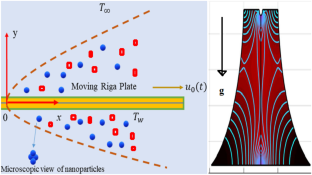Entropy generation analysis combined with hybrid nanofluid flow principles contribute to the development of more efficient drug delivery systems for cancer treatment. By using nanofluids, it is possible to improve the transport and targeted release of therapeutic agents to specific sites in the body, allowing for better control and efficiency in treating cancerous cells. Keeping these important applications in view, in the current analysis, the production of irreversibility and stagnant point hybrid nanofluid flow has been considered on a Riga plate. The impacts of nonlinear convection and solar radiations have also been used in this study. Glycol (C3H8O2) is taken as base fluid, while nanoparticles of copper (Cu) and aluminum oxide (Al2O3) have been mixed in it to obtain a hybrid nanofluid. The leading equations for the study have converted to dimensionless form by employing a set of suitable variables and then have been solved by using an artificial neural network (ANN). In order to evaluate the effectiveness of the least mean square neural network algorithm (LMS-NNA), statistical neural network techniques are employed, encompassing error analysis and curve-fitting graphs. It has been revealed in this work that an upsurge in EMHD Riga plate factor and the Grashof number escalates the velocity distribution for both nanoparticles as well as hybrid nanoparticles and is opposed by augmentation in width factor for electrode/magnet. The increase in the nanoparticle volume fraction from 0.01 to 0.05 escalates the heat transfer rate up to 7.6% in the case of nanofluid with Cu-nanoparticles while this increase is 9.3% using hybrid nanofluid Cu + Al2O3. These results show that HNF are more efficient in improving the HT rate.



